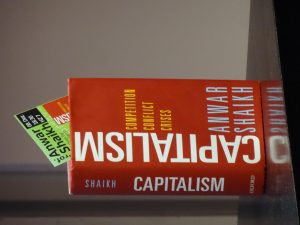A Marxist Analysis of the iPhone
✑ E. AHMET TONAK (TRICONTINENTAL INSTITUTE)` ╱ ± 12 minutes


Workers who make iPhones in the 21st century, are twenty-five times more exploited than textile workers in England in the 19th century. Based on a marxist analysis, the current rate of exploitation is 2458%.

The rate of exploitation is 2458%.

Workers who make iPhones in the 21st century, are twenty-five times more exploited than textile workers in England in the 19th century. Based on a marxist analysis, the current rate of exploitation is 2458%.
From: Tricontinental Institute, September 2019. ╱ About the author
E. Ahmet Tonak (1951) is the author and editor of several books including Measuring the Wealth of Nations: The Political Economy of National Accounts (with Anwar Shaikh), Turkey in Transition: New Perspectives (edited with Irvin Schick) and Marxism and Classes (edited with Sungur Savran and Kurtar Tanyılmaz). Trained as a mechanical engineer at Istanbul Technical University, he earned a Ph.D. in economics from the New School for Social Research. Tonak taught for many years at Istanbul Bilgi University, Middle East Technical University, Bard College at Simon’s Rock, and is currently a visiting professor at UMASS Amherst and works as an economist at Tricontinental Institute for Social Research, Inter-regional Office, Northampton, Massachusetts. He wrote for several Turkish dailies and contributes to sendika.org, an alternative news portal in Turkey..
| Editor’s note: This article is only part 2 of a longer dossier from Tricontinental Institute titled "The Rate of Exploitation (The Case of the iPhone)". Part 1 covers the "Global Commodity Chain" involved in the production of the Iphone. |
|---|
We are interested in looking at the production
of the iPhone – a commodity – through the
framework of a Marxist analysis. We are interested not in being angry at Apple and Foxconn
alone, but in being able to measure how much
workers are exploited to produce this commodity. In other words, we are interested in measuring the rate of exploitation.
The rate of exploitation is one of the most important concepts in Marx’s theory. This measurement allows us to show how much the worker contributes to the increase of value in the production process. It shows that even if the worker is paid more, by the special magic of mechanisation and of efficient management of the production process, the rate of exploitation increases. The rate expresses quantitatively the contradictory interests of the capitalists and of the workers. There is a radical politics implicit in the analysis of the rate of exploitation. It enables workers to see how much of the share of the value produced is appropriated from them by the capitalists, and to therefore make the case for a different way to organise production and to end exploitation.
To understand the rate of exploitation, we have to first grasp what Marx means by the commodity itself and what he means by value, a key term in the Marxist system of economic thought.
What is a commodity? Marx begins his epic work Capital (1867) with a discussion of the commodity. ‘A commodity’, he notes, ‘is an object outside us, a thing that by its properties satisfies human wants of some sort or another. The nature of such wants, whether, for instance, they spring from the stomach or from fancy, makes no difference. Neither are we concerned to know how the object satisfies these wants, whether directly as a means of subsistence, or indirectly as means of production’. The commodity is a useful object. But it is more than a useful thing that serves a purpose to a consumer. It is also something that can be sold – something that enables the person who has it made to realise a profit. Inside the commodity, then, is both use value and value.
The use value of the commodity is merely its utility, something that is left to the consumer. An iPhone is a good example, because it can be used for many things: to make a phone call, to watch a video, to use as a compass, to hold onto when you are feeling awkward (or even to improve your image).
The expression of the value of the commodity (i.e. exchange value) is the price of the commodity. We are aware that there is a rich and long debate amongst Marxists over the relationship between prices and the value of a commodity. This debate is known as the transformation problem – namely the problem of the transformation of values to prices of production. Nevertheless, for our iPhone example, we believe that this level of concreteness need not detain us. We are still able to capture something significant. In the case of the iPhone X, the expression of its value is $999. The value is merely what the commodity is able to command in the market. But behind that price is a mass of crystallised values, which can be grouped into three parts of the total value: constant capital, variable capital, and surplus value. These are key concepts for Marxist analysis.
Constant capital
Various raw materials are brought on to the factory floor that are to be transformed by the actions of labour and machines into commodities. These raw materials – and other auxiliary materials, including the instruments of labour (machines, tools, etc.) – have already been fashioned from nature elsewhere. Inside these raw materials, which are not really ‘raw’ any longer, is embodied labour. The values of the various raw materials and instruments of labour are quantitatively fixed in terms of their labour content. This fixed amount of value is now transferred to the newly produced commodities in the process of production. Its value enters into the new commodities. Karl Marx calls the values of the raw materials and the instruments of labour constant capital.
The constant capital for the iPhone includes all of those minerals and metals that appear on the assembly line as well as the depreciated parts of machines that work those raw materials. These are then collectively transformed into the iPhone. In the process of transformation, the minerals, metals, and machines do not alter their value. Their value is preserved in the iPhone. The value remains constant.
At the end of the process of production, the total transferred value of those means of production – the raw materials, the machines, the buildings – cannot be more than what they originally contained in themselves. Their value, which remains constant, is preserved in the iPhone.
Variable capital.
The capitalist firm makes an initial investment in the production process:
The former expense – the expense on wages and salaries – is known as variable capital. To simplify our calculation, we assume that all workers are productive in the Marxist sense (namely, that they produce surplus value and do not merely distribute surplus value – as do ‘unproductive’ workers, such as those who are involved in trade).
In the capitalist system, people are ‘free’ in two ways. They are free from bondage and free to starve. The freedom from bondage and from the means to feed themselves forces people to sell their capacity to labour to those with capital (land or money). What the person sells is not themselves (since they are free from bondage), but they sell their labour power in exchange for wages. The wages correspond to a certain amount of money – representing a certain amount of value – that is necessary to satisfy the consumption needs of the workers.
Marx called labour power a peculiar commodity. Like other commodities, this one must have two aspects – a use value and a value. Wages are the exchange value of labour power, whereas labour is the use value of labour power. This distinction between the use value of labour power and the exchange value of labour power is fundamental to a Marxist understanding of surplus value and its production.
In a given working day, workers transform their capacity to labour into an act of labour. Their various skills are utilised to transform raw materials and machines into commodities.
Workers produce more value than they are paid in wages. This extra value is called surplus value. If the management of labour changes or if the machines work at a different speed, then either more or less value is produced in a day, which means that the surplus value can be increased (or decreased). The fact that labour power – this peculiar commodity – has the quality of producing an extra amount of value than what is needed for its own reproduction makes it variable capital.
Surplus Value
The various raw materials that are on the assembly line, the machines, and the electricity that help fashion the raw materials, would all be idle without the necessary work of the labour power put into the system by the workers. The workers take the raw materials and the tools and shape them into a commodity. It is the input of the labour power that is crucial. Unlike any other commodity, the labour power purchased from the worker has to produce these new values. When the workers tire, they go home and reproduce their labour power to be sold again.
The workers sell their labour power for a set amount of money. When they start to work on the production of commodities, it takes them only a fraction of their working day to make enough commodities to cover their own wages. Marx called that the necessary labour time. It was ‘necessary’ because in different epochs and in different countries it takes different amounts of goods and services to reproduce the worker’s depleted labour power. In some countries, the standard of living is lower than that of others, which means the necessary labour time is also shorter. The remainder of the working day – after the necessary labour time – is the surplus labour time. It is the time that the worker spends producing commodities that are above and beyond the amount needed to be produced to pay the wage bill of the worker.
Rate of Surplus Value
Marx’s concept – the rate of exploitation – is measured by using the categories of variable capital and surplus value. Variable capital is the share of the values produced in the process of production that goes to the workers. Surplus value, on the other hand, is the share of the values that goes to the capitalist. The ratio of surplus value to variable capital – or s/v – can be seen as a quantitative expression of the exploitation of workers, also called the rate of surplus value.
Take a hypothetical commodity whose total value is $1,000. The constant capital is worth $500. That capital – raw material, tools and energy – goes into the process of production and remerges in a different form but with the value intact. There is no change in its value. The variable capital – what the worker earns – is $250. The surplus value – what the capitalist appropriates – is the amount of value created during the surplus labour time, which in our example happens to be $250.
The rate of exploitation is measured by s/v, or the surplus value divided by the variable capital. The numbers for this hypothetical commodity provide us with the following definitional equation:
s/v = $250/$250 = 100%
The rate of exploitation of labour here is 100%. For every dollar that the worker earns, the capitalist appropriates surplus value of $1.
We now have the conceptual tools to measure the rate of exploitation of the workers who produce the iPhone. It should be pointed out that any attempt to empirically calculate Marx’s labour theory of value must necessarily make assumptions that simplify reality. In our view, however, these assumptions – such as that prices reflect values – can be justified and that these simplifications do not exaggerate the results (Shaikh and Tonak, 1994).
We begin with the sale price of the iPhone X in the United States – $999. This amount, we believe, roughly represents the total value embodied in the commodity. In any commodity produced in a capitalist production process, the mass of embodied values contains three value parts: constant capital, variable capital, and surplus value. Therefore, we must estimate the value of those segments of the total value of the iPhone X.
Constant Capital. Data from TechInsights gives us a detailed and specific look at the prices of components of both the iPhone XS Max and the iPhone X.
The total component prices of these two models are respectively $453 and $395.44. The first bar in the columns, however, includes the cost of ‘test/assembly/supporting materials’. This confuses the data for the analytical distinctions made by Marx. ‘Test/Assembly’ belongs to the variable capital, since, in both, labour power must be purchased to do those jobs. However, ‘supporting material’ is merely another part of the raw materials and belongs to the constant capital. To make matters simple, we exclude this portion of the top item from our estimation of the constant capital. Hence, the amounts that roughly represent the constant capital would be $428.50 ($453 - $24.50) and $370.89 ($395.44 - $24.55).
Drawing upon the iPhone X, we will consider the amount for constant capital to be $370.89.
Variable Capital. The estimation of the variable portion of the total value of the iPhone is more problematic. We are faced with the secretiveness of Apple, which does not release wage data. Two additional problems of the data need to be acknowledged. First, we do not have complete information on the expenditure by Apple for the initial research and design of the iPhone. We believe that the initial research and design labour costs can be ignored since these costs have been spread out over different models of the iPhone and the contribution of the research and development cost is increasingly negligible for the newer iPhones. Second, we do not have clear data on the wage differentials between workers who produce different components of the iPhone in different countries. This wage differential can be ignored because most of the companies that produce components for the iPhone are located in wage zones where this differentiation is not substantial. In fact, since we are estimating the wage bill based on the manufacturing side and leaving out the extraction of raw materials, we are inflating rather than deflating the wage bill.
We find these assumptions to be acceptable on the grounds that our figure of variable capital ($24.55) is based on ‘test/assembly/supporting materials’, which probably overestimates the extent of productive labour used in the process of making the iPhone X.
What is the rate of exploitation?
What does this number – 2458% – tell us? It tells us that an infinitesimal part of the working day is devoted to the value needed by the workers as wages. The bulk of the day is spent by the worker producing goods that enhance the wealth of the capitalist. The higher the rate of exploitation, the greater the enhancement of the capital’s wealth by the worker’s labour.
The rate of exploitation is one of the most important concepts in Marx’s theory. This measurement allows us to show how much the worker contributes to the increase of value in the production process. It shows that even if the worker is paid more, by the special magic of mechanisation and of efficient management of the production process, the rate of exploitation increases. The rate expresses quantitatively the contradictory interests of the capitalists and of the workers. There is a radical politics implicit in the analysis of the rate of exploitation. It enables workers to see how much of the share of the value produced is appropriated from them by the capitalists, and to therefore make the case for a different way to organise production and to end exploitation.
To understand the rate of exploitation, we have to first grasp what Marx means by the commodity itself and what he means by value, a key term in the Marxist system of economic thought.
What is a commodity? Marx begins his epic work Capital (1867) with a discussion of the commodity. ‘A commodity’, he notes, ‘is an object outside us, a thing that by its properties satisfies human wants of some sort or another. The nature of such wants, whether, for instance, they spring from the stomach or from fancy, makes no difference. Neither are we concerned to know how the object satisfies these wants, whether directly as a means of subsistence, or indirectly as means of production’. The commodity is a useful object. But it is more than a useful thing that serves a purpose to a consumer. It is also something that can be sold – something that enables the person who has it made to realise a profit. Inside the commodity, then, is both use value and value.
The use value of the commodity is merely its utility, something that is left to the consumer. An iPhone is a good example, because it can be used for many things: to make a phone call, to watch a video, to use as a compass, to hold onto when you are feeling awkward (or even to improve your image).
The expression of the value of the commodity (i.e. exchange value) is the price of the commodity. We are aware that there is a rich and long debate amongst Marxists over the relationship between prices and the value of a commodity. This debate is known as the transformation problem – namely the problem of the transformation of values to prices of production. Nevertheless, for our iPhone example, we believe that this level of concreteness need not detain us. We are still able to capture something significant. In the case of the iPhone X, the expression of its value is $999. The value is merely what the commodity is able to command in the market. But behind that price is a mass of crystallised values, which can be grouped into three parts of the total value: constant capital, variable capital, and surplus value. These are key concepts for Marxist analysis.
Constant capital
Various raw materials are brought on to the factory floor that are to be transformed by the actions of labour and machines into commodities. These raw materials – and other auxiliary materials, including the instruments of labour (machines, tools, etc.) – have already been fashioned from nature elsewhere. Inside these raw materials, which are not really ‘raw’ any longer, is embodied labour. The values of the various raw materials and instruments of labour are quantitatively fixed in terms of their labour content. This fixed amount of value is now transferred to the newly produced commodities in the process of production. Its value enters into the new commodities. Karl Marx calls the values of the raw materials and the instruments of labour constant capital.
The constant capital for the iPhone includes all of those minerals and metals that appear on the assembly line as well as the depreciated parts of machines that work those raw materials. These are then collectively transformed into the iPhone. In the process of transformation, the minerals, metals, and machines do not alter their value. Their value is preserved in the iPhone. The value remains constant.
At the end of the process of production, the total transferred value of those means of production – the raw materials, the machines, the buildings – cannot be more than what they originally contained in themselves. Their value, which remains constant, is preserved in the iPhone.
Variable capital.
The capitalist firm makes an initial investment in the production process:
- Wages and salaries for workers.
- Expenses on all non-human inputs, notably tools, machinery, buildings, energy, and so on.
The former expense – the expense on wages and salaries – is known as variable capital. To simplify our calculation, we assume that all workers are productive in the Marxist sense (namely, that they produce surplus value and do not merely distribute surplus value – as do ‘unproductive’ workers, such as those who are involved in trade).
In the capitalist system, people are ‘free’ in two ways. They are free from bondage and free to starve. The freedom from bondage and from the means to feed themselves forces people to sell their capacity to labour to those with capital (land or money). What the person sells is not themselves (since they are free from bondage), but they sell their labour power in exchange for wages. The wages correspond to a certain amount of money – representing a certain amount of value – that is necessary to satisfy the consumption needs of the workers.
Marx called labour power a peculiar commodity. Like other commodities, this one must have two aspects – a use value and a value. Wages are the exchange value of labour power, whereas labour is the use value of labour power. This distinction between the use value of labour power and the exchange value of labour power is fundamental to a Marxist understanding of surplus value and its production.
In a given working day, workers transform their capacity to labour into an act of labour. Their various skills are utilised to transform raw materials and machines into commodities.
Workers produce more value than they are paid in wages. This extra value is called surplus value.During the working day and given the conditions of work, the total amount of value produced by the workers exceeds what is needed for their own consumption and reproduction. The value they require for their consumption and reproduction – represented in wages – is only a part of the value that they make during the working day.
Workers produce more value than they are paid in wages. This extra value is called surplus value. If the management of labour changes or if the machines work at a different speed, then either more or less value is produced in a day, which means that the surplus value can be increased (or decreased). The fact that labour power – this peculiar commodity – has the quality of producing an extra amount of value than what is needed for its own reproduction makes it variable capital.
Surplus Value
The various raw materials that are on the assembly line, the machines, and the electricity that help fashion the raw materials, would all be idle without the necessary work of the labour power put into the system by the workers. The workers take the raw materials and the tools and shape them into a commodity. It is the input of the labour power that is crucial. Unlike any other commodity, the labour power purchased from the worker has to produce these new values. When the workers tire, they go home and reproduce their labour power to be sold again.
The workers sell their labour power for a set amount of money. When they start to work on the production of commodities, it takes them only a fraction of their working day to make enough commodities to cover their own wages. Marx called that the necessary labour time. It was ‘necessary’ because in different epochs and in different countries it takes different amounts of goods and services to reproduce the worker’s depleted labour power. In some countries, the standard of living is lower than that of others, which means the necessary labour time is also shorter. The remainder of the working day – after the necessary labour time – is the surplus labour time. It is the time that the worker spends producing commodities that are above and beyond the amount needed to be produced to pay the wage bill of the worker.
Rate of Surplus Value
Marx’s concept – the rate of exploitation – is measured by using the categories of variable capital and surplus value. Variable capital is the share of the values produced in the process of production that goes to the workers. Surplus value, on the other hand, is the share of the values that goes to the capitalist. The ratio of surplus value to variable capital – or s/v – can be seen as a quantitative expression of the exploitation of workers, also called the rate of surplus value.
Take a hypothetical commodity whose total value is $1,000. The constant capital is worth $500. That capital – raw material, tools and energy – goes into the process of production and remerges in a different form but with the value intact. There is no change in its value. The variable capital – what the worker earns – is $250. The surplus value – what the capitalist appropriates – is the amount of value created during the surplus labour time, which in our example happens to be $250.
The rate of exploitation is measured by s/v, or the surplus value divided by the variable capital. The numbers for this hypothetical commodity provide us with the following definitional equation:
s/v = $250/$250 = 100%
The rate of exploitation of labour here is 100%. For every dollar that the worker earns, the capitalist appropriates surplus value of $1.
We now have the conceptual tools to measure the rate of exploitation of the workers who produce the iPhone. It should be pointed out that any attempt to empirically calculate Marx’s labour theory of value must necessarily make assumptions that simplify reality. In our view, however, these assumptions – such as that prices reflect values – can be justified and that these simplifications do not exaggerate the results (Shaikh and Tonak, 1994).
| The procedure used in this Notebook to calculate the rate of surplus value in the Apple iPhone X is similar to the way Karl Marx calculated the rate of surplus value in yarn production. In Capital I, Marx wrote, ‘[T]he constant portion of the value of the week’s product is £378. Wages amount to £52 a week. The price of yarn … is the sum of £510. The surplus value is therefore in this case £510 - £430 = £80 ... The rate of surplus value is therefore 80/52 = 153 11/13%’. |
|---|
We begin with the sale price of the iPhone X in the United States – $999. This amount, we believe, roughly represents the total value embodied in the commodity. In any commodity produced in a capitalist production process, the mass of embodied values contains three value parts: constant capital, variable capital, and surplus value. Therefore, we must estimate the value of those segments of the total value of the iPhone X.
Constant Capital. Data from TechInsights gives us a detailed and specific look at the prices of components of both the iPhone XS Max and the iPhone X.
The total component prices of these two models are respectively $453 and $395.44. The first bar in the columns, however, includes the cost of ‘test/assembly/supporting materials’. This confuses the data for the analytical distinctions made by Marx. ‘Test/Assembly’ belongs to the variable capital, since, in both, labour power must be purchased to do those jobs. However, ‘supporting material’ is merely another part of the raw materials and belongs to the constant capital. To make matters simple, we exclude this portion of the top item from our estimation of the constant capital. Hence, the amounts that roughly represent the constant capital would be $428.50 ($453 - $24.50) and $370.89 ($395.44 - $24.55).
Drawing upon the iPhone X, we will consider the amount for constant capital to be $370.89.
Variable Capital. The estimation of the variable portion of the total value of the iPhone is more problematic. We are faced with the secretiveness of Apple, which does not release wage data. Two additional problems of the data need to be acknowledged. First, we do not have complete information on the expenditure by Apple for the initial research and design of the iPhone. We believe that the initial research and design labour costs can be ignored since these costs have been spread out over different models of the iPhone and the contribution of the research and development cost is increasingly negligible for the newer iPhones. Second, we do not have clear data on the wage differentials between workers who produce different components of the iPhone in different countries. This wage differential can be ignored because most of the companies that produce components for the iPhone are located in wage zones where this differentiation is not substantial. In fact, since we are estimating the wage bill based on the manufacturing side and leaving out the extraction of raw materials, we are inflating rather than deflating the wage bill.
We find these assumptions to be acceptable on the grounds that our figure of variable capital ($24.55) is based on ‘test/assembly/supporting materials’, which probably overestimates the extent of productive labour used in the process of making the iPhone X.
- Total value of iPhone = $999.
- Constant capital = $370.89.
- Variable capital = $24.55.
- Surplus value = (total value) – (constant capital + variable capital).
- $999 – ($370.89 + $24.55) = $603.56.
What is the rate of exploitation?
- s/v = 603.56/24.55 = 2458%.
What does this number – 2458% – tell us? It tells us that an infinitesimal part of the working day is devoted to the value needed by the workers as wages. The bulk of the day is spent by the worker producing goods that enhance the wealth of the capitalist. The higher the rate of exploitation, the greater the enhancement of the capital’s wealth by the worker’s labour.
- This was part 2 from a longer dossier by Tricontinental Institute titled "The Rate of Exploitation (The Case of the iPhone)"
| Top image: Value of an iPhone: surplus value, variable capital and constant capital. From: Tricontinental Institute |
|---|





























Comments
Post a Comment
Your thoughts...